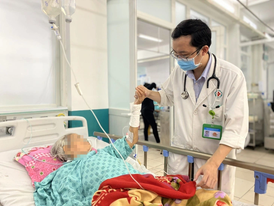Vietnam needs to have more stroke treatment facilities of high quality to meet the demand for treatment as Vietnamese people have one of the highest risks of stroke in the world, an expert has warned.
The warning was released by Assoc. Prof. Dr. Nguyen Huy Thang, chairman of the Ho Chi Minh City Stroke Association, at ‘Vietnam Stroke Treatment Quality Management Symposium 2023,' conducted by the association on Friday.
Dr. Thang said that our country has made great strides in stroke quality management such as standardizing stroke programs, developing stroke programs, and establishing more stroke units.
Currently, the country has more than 100 stroke units that provide patients with opportunities for timely emergency treatment and recovery, improve quality in patient care, and contribute to reducing the stroke-caused burden on families and society, the expert said.
Dr. Thang, who is also head of the cerebrovascular disease ward at the city-based People’s Hospital 115, expressed his hope that more stroke units of higher quality will be set up in the coming time to meet the demand for treatment.
A stroke unit is defined as a dedicated, clearly defined area or ward in a hospital where stroke patients are admitted and cared for by a multi-professional team, according to the European Stroke Organization.
Early this month, Dr. Thang warned that Vietnam, with an estimated rate of 218 stroke patients per 100,000 people, is among the countries most vulnerable to stroke, one of the leading causes of death and disability worldwide.
After 18 years since the first stroke unit was set up at the People’s Hospital 115 in 2005, the country now has 110 stroke treatment facilities but the required number is over 400, Dr. Thang said.
As a result, it takes many patients in many provinces several hours to reach the nearest stroke treatment unit.
Moreover, every stroke unit in Vietnam has to take care of over 2,000 patients per year on average, compared to only 300 in the U.S..
According to some recommendations, it is ideal for a stroke unit in Vietnam to accommodate 500 patients at most, Dr. Thang said.
Speaking at the event, Prof. Dr. Jeyaraj Durai Pandian, president of the World Stroke Organization (WSO), emphasized that stroke is a global burden, with about 12 million new stroke cases every year.
On average, one in every four people in the world is at risk of suffering a stroke once in a lifetime, Dr. Pandian warned.
Currently, Asia leads the world in the number of stroke patients, followed by Africa, he said, adding that the older the population of a country gets, the higher the rate of stroke becomes.
Therefore, it is necessary to improve the ability to identify people suffering a stroke as well as those at risk, and then give them emergency treatment as soon as possible, the WSO leader advised.
The most effective stroke treatments can be achieved if the stroke episode is recognized and diagnosed within three hours of the first symptoms, according to the U.S. Centers for Disease Control and Prevention (CDC).
Also at the event, Dr. Pandian awarded the certificate of treatment quality standards of the WSA to 36 hospitals across Vietnam.
Among the hospitals, 20 got gold certificates, nine received platinum certificates, and the others won diamond certificates.
A stroke occurs when blood supply to part of the brain is blocked or when a blood vessel in the brain bursts, and in either case, parts of the brain become damaged or die, according to the CDC.
A stroke can cause lasting brain damage, long-term disability, or even death, the agency warns.
People are advised to seek medical help immediately if they have any of these signs of stroke: numbness or weakness in the face, arm, or leg; severe headache with no known cause, trouble seeing in one or both eyes; confusion or trouble speaking or understanding speech; and trouble walking, dizziness, or problems with balance.
Like us on Facebook or follow us on Twitter to get the latest news about Vietnam!



















































